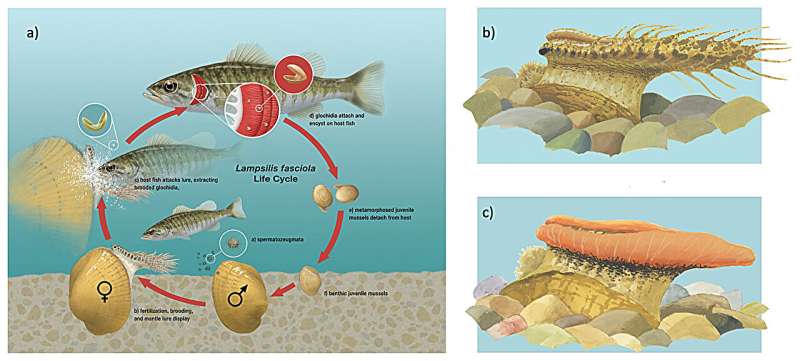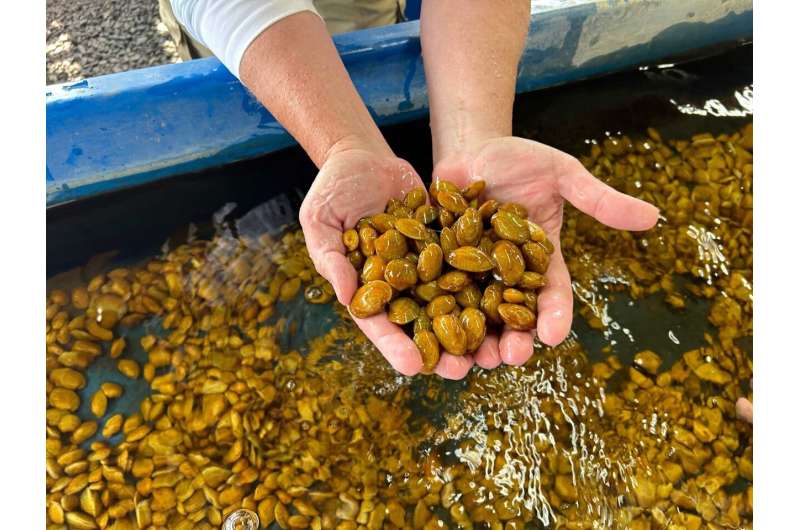This article has been reviewed according to Science X's editorial process and policies. Editors have highlighted the following attributes while ensuring the content's credibility:
fact-checked
peer-reviewed publication
trusted source
proofread
Q&A: Investigating the remarkable reproductive cycle of Michigan's threatened mollusks

Michigan is home to 43 species of native freshwater mussels, 30 of which are considered to be at risk of extinction. Among the many factors that threaten the hard-shelled bottom dwellers are competition from invasive zebra and quagga mussels, water pollution, and—especially—dams.
The Huron River in Southeast Michigan, for example, has 19 dams on its main stem and at least 96 across its entire drainage. Damming completely transforms a river's ecology, replacing native mussel-rich shoal, riffle, and pool habitats with less suitable lake-like reservoirs.
Two University of Michigan biologists led a recent freshwater mussel study based on fieldwork along the Huron River and the River Raisin, also in Southeast Michigan. The study, published May 24 in the journal PeerJ, investigates freshwater mussels' remarkable reproductive cycle, which includes the use of fleshy "mantle lures" by pregnant females to attract nearby fish and "infect" them with mussel larvae.
The study's lead author, Trevor Hewitt, conducted the fieldwork for his doctoral dissertation in the U-M Department of Ecology and Evolutionary Biology. The senior author, Diarmaid Ó Foighil, is a professor in the department and was Hewitt's adviser.
What background information would someone who is completely unfamiliar with your field need to know to understand the findings of your study?
Hewitt: Freshwater mussels undergo an obligate parasitic larval development in which pregnant females must infect a suitable fish host with her young. The mussel larvae typically attach to the host fish's gills, and after two to four weeks they metamorphose into juveniles and drop to the riverbed. Many mussel species are host specialists, infecting just one or a few species of fish, and utilizing distinct host infection strategies.
One of the most striking strategies involves use of a mantle lure. This is a pigmented tissue flap displayed by pregnant females to mimic a host prey item (a small fish, an invertebrate, etc.), eliciting an attack by the host fish and resulting in its infection.
Mantle lure displays are a remarkable and understudied example of mimicry in nature that occurs in many of our streams and rivers each spring and summer.
What exact research question did you set out to answer, and what methods did you use?
Hewitt: Our research focused on the mantle-lure diversity present in one mussel species, the wavy-rayed lampmussel, which is found from Michigan to Alabama. This mussel uses smallmouth bass as its primary fish host and, most unusually, it has two highly distinctive types of mantle lures.
One, previously termed "darter-like," resembles a small fish called a darter, complete with eye spots, mottled body coloration and prominent marginal extensions including a tail. The other, previously termed "worm-like," is uniformly bright orange underlain with black. Both lure forms, or morphs, co-occur throughout the animal's range.

Our research aims were to: confirm that the mantle lure diversity represents a true polymorphism, meaning a clearly different form within a population of the species; investigate its ecological persistence through time; identify the range of putative model species targeted by this mimicry system in a natural population; and determine whether the two mantle lure morphs differ in their display behavior in addition to their pigmentation and morphology.
What are the most important findings of your study, and how do they go beyond previous studies of this topic?
Ó Foighil: We were able to demonstrate that the mantle lure morph diversity in this species is a true polymorphism using two independent criteria: evolutionary trees based on genomic data and inheritance of both morphs within a captive-raised brood—the first such record in freshwater mussels.
Using museum specimens from a River Raisin population, we found that the polymorphism appears stable over ecological time frames. The ratio of the two lure morphs in 2017 was consistent with that of museum samples collected at the same site six decades earlier.
We were able to identify likely model species for the mantle lure variants—meaning the species of fish or invertebrates the mantle lures mimic—within the River Raisin mussel population. Four main darter-like lure motifs visually approximated four co-occurring darter fish species, and the worm-like lure resembled the North American medicinal leech. Darters and leeches are typical prey of smallmouth bass.
Using a GoPro camera, field recordings were made of the darter and leech lure display behaviors in the River Raisin and the Huron River. The displays were largely similar despite the pronounced difference in lure appearance and in model species, implying that the mimicry is only skin deep.
Were there any big surprises?
Hewitt: There were several big surprises. Most important was the unexpected discovery of within-brood mantle lure polymorphism, meaning that different forms of the mantle lure were found within a single group of offspring laid by a female mussel. This critical result was hard-earned, requiring infection of fish hosts and two years of juvenile mussel culture at the Alabama Aquatic Biodiversity Center.
Another surprise was the discovery of 1950s mussel samples from our River Raisin study site in the U-M Museum of Zoology's mollusk collection. The mantle lures on these old specimens were still intact, and they enabled us to compare the ratio of the leech lure morph to the darter lure morph over a 60-plus-year period.
What are the main implications or potential applications of these findings?
Ó Foighil: Discovery of discrete within-brood inheritance of the mantle lure polymorphism is particularly exciting because it implies potential control by a single genetic locus. Virtually nothing is known about the regulatory genes that control mantle lures, representing a significant knowledge gap. Our results identify the wavy-rayed lampmussel as a promising study system to identify the regulatory genes controlling a key adaptive trait of North American endangered freshwater mussels.
The other authors of the PeerJ study are Paul Johnson and Michael Buntin of the Alabama Aquatic Biodiversity Center and Talia Moore of the University of Michigan.
More information: Trevor L. Hewitt et al, Polymorphism in the aggressive mimicry lure of the parasitic freshwater mussel Lampsilis fasciola, PeerJ (2024). DOI: 10.7717/peerj.17359
Journal information: PeerJ
Provided by University of Michigan




















